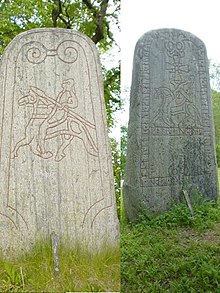Runestone from Skokloster
One of the rune stones from Skokloster ( Rundata U 678) at the church of Skokloster in the municipality of Håbo in Uppland in Sweden is one of the rather rare rune stones. The rune stone shows a troll mask, a cross and the artistic image of a rider from the Viking Age (800–1050 AD), which was probably inspired by continental representations (e.g. the Reiterstein von Hornhausen ). It is not known where the Skokloster stone originally came from.
The large rune stone, carved on both sides, stands on a hill east of the church. Johannes Bureus (1568–1652), Sweden's first rune researcher, has already studied the text. It reads: “Andvätt and Gullev and Gunnar and Horse and Rolev had the stone made according to Tord, their father. Fot scratched the runes ”.
Apparently the inscription comes from one of the leading rune masters ( Urilaz , New Swedish Runristare ) Fot, who signed seven other stones. The ornamentation is not his, but the runes and the security of the lines are the same. Researchers justify the archaic style of the two equestrian representations on the front and back with the fact that Fot used an older picture stone and only created the rune band around the subject. Although the equestrian image can be assigned to art of the 7th and 8th centuries, this is unlikely. There is a 7th century bronze work by Veggerslev in Denmark and a representation on a Gotland stone that looks similar. The back of the stone looks like a rune stone waiting to be inscribed. Some researchers believe the page is unfinished. The difference is that the rider carries a sword on the front while the one on the back carries a lance.
In Bureus times the stone lay in the floor of the church and had been worn out over the years. Also Anders Celsius (1701-1744) saw the stone in 1727 at this place. When Carl Fredrik Rothlieb (1783–1835) wrote about it in 1819, he saw the reverse side, so the stone must have been turned. In the 1860s Richard Dybeck (1811–1877) came to Skokloster during one of his trips and had the stone removed from the ground. It was given its current location in the 1890s.
The equestrian stone shows parallels to the much older Möjbrostein and one of the rune stones in Ålum Kirke .
See also
literature
- Erik Nylén , Jan Peder Lamm: Picture stones on Gotland. Wachholtz, Neumünster 1981, (2nd, expanded and completed German edition. Ibid 1991, ISBN 3-529-01823-6 ).
- R. Schwarz: The warrior's last ride to Valhalla In: State Museum for Prehistory (Hrsg.): Beauty, power and death. 2002, ISBN 3-910010-64-4 , p. 58.
Web links
- Runestone from Skokloster - entry in the database "Fornsök" des Riksantikvarieämbetet (Swedish)
- Description and pictures (Swedish)
Coordinates: 59 ° 42 ′ 16.3 " N , 17 ° 37 ′ 28.3" E
